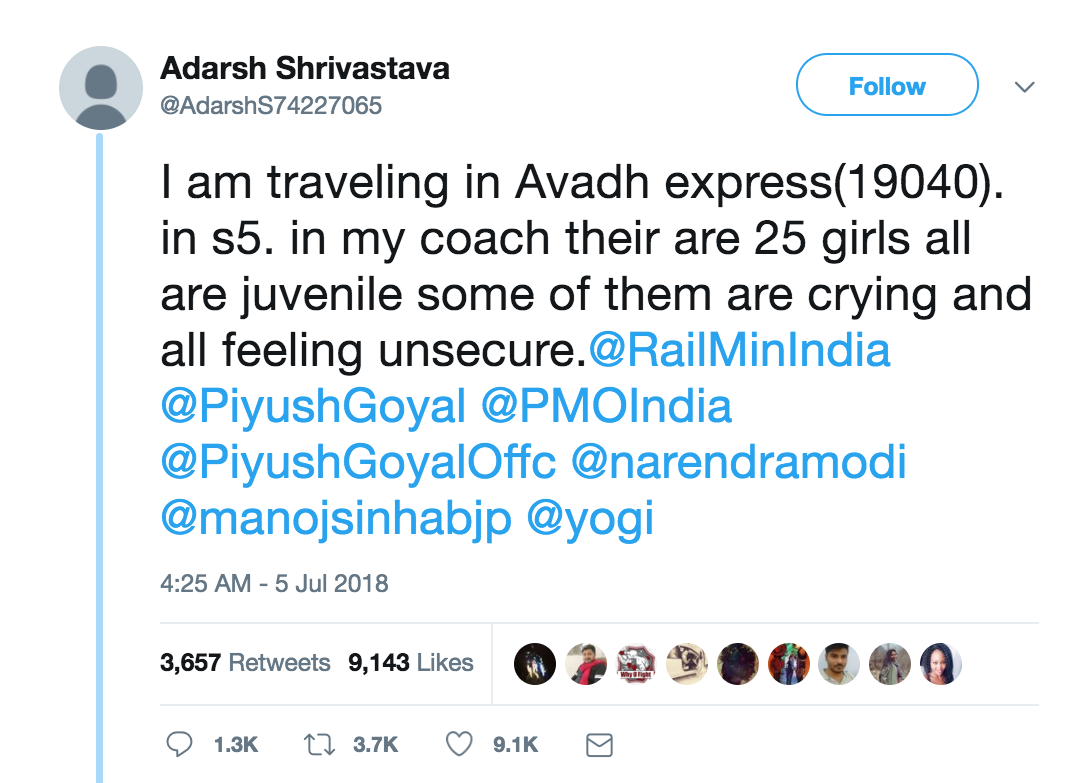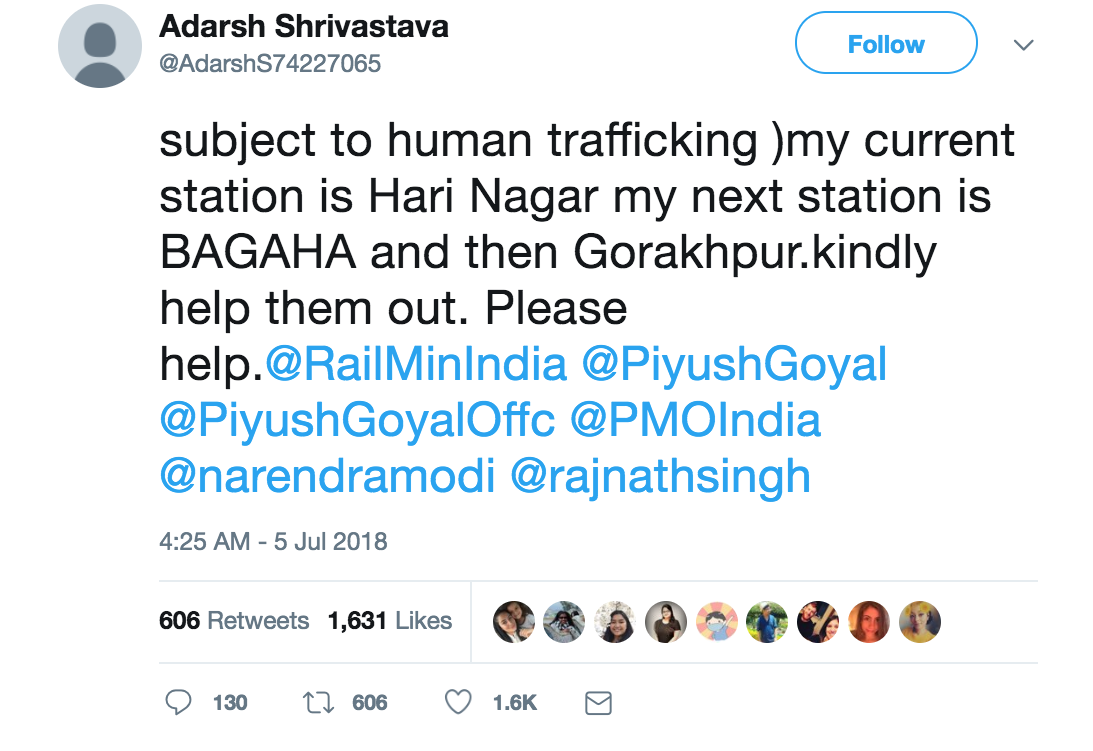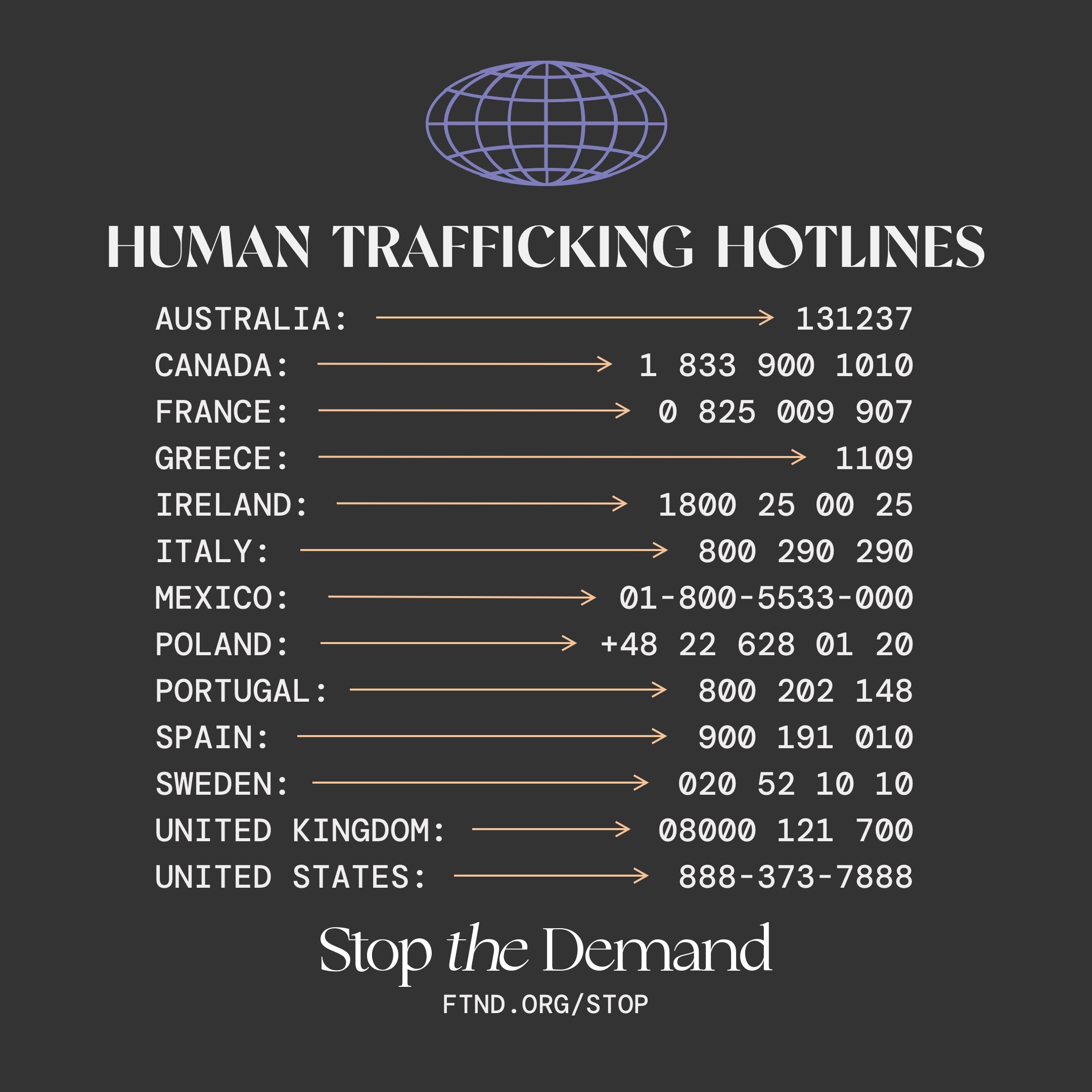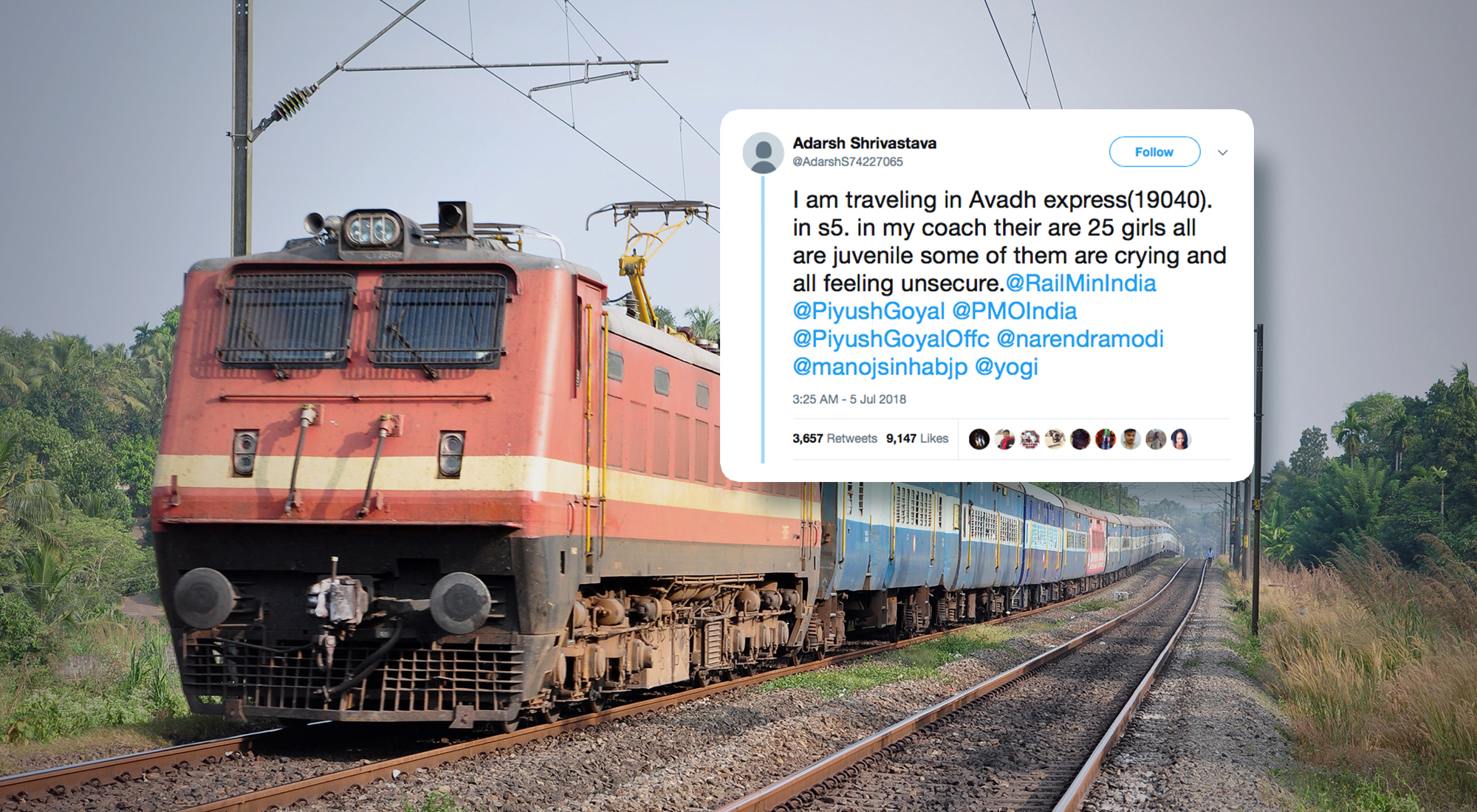“If you see something, say something.”
Many of us see this phrase plastered on posters and signs at public transportation stations, but how many of us take the time to actually say something when we do see something suspicious?
More than two dozen Indian girls are safe from human traffickers after a man alerted authorities with just a couple of tweets.
Speaking up with just two tweets
This story is not a new one—it’s from the summer of 2018—but it’s no less relevant. From it, we can learn so much about the importance of speaking up.
Reports circulated about an Indian man named Adarsh Shrivastava was traveling through the Northern Indian State of Uttar Pradesh when he noticed a suspicious situation on his train: 25 girls, all between the ages of 10 and 14, appearing restless and nervous in his cabin.
Related: How OnlyFans Reportedly Facilitates And Profits From Child Sex Trafficking
So he did what he could, and tweeted out a call for help, tagging India’s railway authorities along with a few others in two tweets. And after further inspection of his Twitter account, it looks like he created this twitter specifically to alert the authorities:


Less than a half-hour later, reports say the Ministry of Railways had alerted local rail authorities to the situation. After a few additional stops, plainclothes officers boarded the train and arrested two men and took the young girls into custody, according to a report from the Press Trust of India, citing railway officials.
A classic sign of a trafficking situation, the girls struggled to provide authorities with details on who their parents or guardians were. They were later transferred to state child welfare authorities, who are working with the girls to reconnect them with the rightful guardians. The Indian government’s Indian Railway Protection Force determined that all the girls were from West Champaran in Bihar, which is located in northeast India.
Related: Did You Know Men And Boys Can Be Victims Of Sex Trafficking, Too?
When media outlets and people from all over the world have reached out to Shrivastava, giving him kudos for speaking up, he simply replies, “Thanks, but as a sitizen [sic] of India it’s our responsibility to help people.” What a cool guy.
Uttar Pradesh and the issue of exploitation
Seeing a positive story like this come out of Uttar Pradesh is awesome, considering the rampant issue of sexual exploitation that the region is dealing with.
The Times of India reported that shops are selling hundreds, perhaps thousands, of real-life rape videos every day across Uttar Pradesh. Unfortunately, this is happening right under the nose of the police and the government. Depending on the “exclusivity” of the clips, which range from 30 seconds to even five minutes long, they are priced anywhere from 50 to 150 Rupees, which is about $.75 to $2.25.
Related: Do Some Videos On Mainstream Porn Sites Actually Show Sex Trafficking?
According to reports, it’s still “under the counter” and dealers will talk only to those who’ve come armed with a trusted customer’s “reference,” but it is open and rampant.
“Porn is passe. These real-life crimes are the rage,” said a shopkeeper at Agra’s market. “Dealers will download videos directly into your smartphone or put them in your pen drive.”
This is unacceptable. We hope that those who are capitalizing on the actual abuse and torture of real people will be caught and held accountable.
Related: 10 Surprising Facts About Human Trafficking In The U.S.
But what does any of this have to do with porn?
As an anti-porn, pro-love, and pro-sex organization, it might seem confusing that we’re talking about “sexual exploitation” and human trafficking. What’s the relevance?
We’re glad you asked.
Of all the millions—possibly billions—of porn consumers in the world, not many know this fact: porn, sex trafficking, and sexual exploitation are all inextricably linked.
There are different ways that pornography and sex trafficking are connected. But first, let’s define what sex trafficking actually is.
Related: By The Numbers: Is The Porn Industry Connected To Sex Trafficking?
According to The Trafficking Victims Protection Act—one of the most comprehensive anti-trafficking laws ever passed in the U.S.—the definition of human sex trafficking specifically defines a human trafficking victim as a person induced to “perform labor or a commercial sex act, through force, fraud, or coercion.”
An individual under the age of 18 (a minor) who specifically performs a commercial sex act will automatically fall under the category of human trafficking. Regardless of any of the following things like force, fraud, or coercion were actually present at the time, it is still considered sex slavery.
Keep in mind that someone can be sex trafficked even if they receive a paycheck at the end of the day and sleep in their own bed. Being chained up or transported across state lines is certainly part of what can happen during a trafficking experience, but extreme elements like that are not required for trafficking to take place. All that is required for a situation to be sex trafficking is that something of value is exchanged for a sex act—”a commercial sex act”—and that act is induced by force, fraud, or coercion.
Related: How Porn Fuels Sex Trafficking
So how do videos of trafficked individuals end up on popular porn sites? There are a few different ways:
- An unsuspecting individual is forced, tricked, or coerced into shooting sex on camera and that footage is distributed
- A professional porn performer is forced, tricked, or coerced into sex acts that make them uncomfortable and that footage is distributed
- Sexual videos and/or images are taken of already trafficked individuals and then uploaded to porn sites
- Videos and/or images of underage individuals in commercial sexual situations are uploaded to porn sites
Not all videos on porn sites feature trafficked individuals, and not all porn is nonconsensual. Even so, there is often no way to tell if the porn a consumer views is completely consensual or produced with coercion.
How porn fuels trafficking, and vice versa
And if you’re not convinced content on mainstream sites isn’t all consensual, read this Jezebel.com story, this story on Daily Beast, this story on Complex.com, this Rolling Stone story, this Daily Beast story, this Bustle.com story, this story on CNN, this NY Post story, this Gizmodo.com story, this BBC report, this Florida Sun-Sentinel report, this Daily Wire story, this Buzzfeed News profile, and this UK Independent story for further cases that show the mainstream porn industry features nonconsensual videos and videos of trafficked individuals. And yes, this includes videos on Pornhub and other mainstream porn sites, as well as non-mainstream sites like OnlyFans.
Related: How To Report Human Trafficking When You See Something Suspicious
There isn’t a clear-cut way of knowing who has been exploited, and who hasn’t. But it’s also worth knowing that porn and sex trafficking are connected in other ways, too.
Porn has been shown to fuel trafficking, and vice versa. Anti-trafficking expert Dr. Karen Countryman-Roswurm explains it in this way:
“Through the cycle of pornography-fueled physical and sexual abuse, pornography perpetuates further perpetration. Many of the individuals photographed or filmed for the use of pornography have a history of sexual abuse. Many still, while being materialized for citizens all across the world, are seemingly accepting such abuse and exploitation under the force, fraud, or coercion of a trafficker…
Pornography is the material means of sexual exploitation. Pornography is the proof, the very evidence that commercial sexual exploitation occurred. Pornography is verification of violence. And pornography is used again and again to prime, promote, and perpetuate the perpetration of boys and girls for the purpose of sex trafficking.”
Related: 5 Ways You Can Help Fight Human Sex Trafficking In Your Daily Life
Where do you stand when it comes to this? Will you feed into modern-day slavery by clicking porn, or are you fighting for real, authentic, and genuine love?
It’s time to be a voice against exploitation, and not accept exploitation as the norm. Fight with us to stop the demand for exploitation.

Your Support Matters Now More Than Ever
Most kids today are exposed to porn by the age of 12. By the time they’re teenagers, 75% of boys and 70% of girls have already viewed itRobb, M.B., & Mann, S. (2023). Teens and pornography. San Francisco, CA: Common Sense.Copy —often before they’ve had a single healthy conversation about it.
Even more concerning: over half of boys and nearly 40% of girls believe porn is a realistic depiction of sexMartellozzo, E., Monaghan, A., Adler, J. R., Davidson, J., Leyva, R., & Horvath, M. A. H. (2016). “I wasn’t sure it was normal to watch it”: A quantitative and qualitative examination of the impact of online pornography on the values, attitudes, beliefs and behaviours of children and young people. Middlesex University, NSPCC, & Office of the Children’s Commissioner.Copy . And among teens who have seen porn, more than 79% of teens use it to learn how to have sexRobb, M.B., & Mann, S. (2023). Teens and pornography. San Francisco, CA: Common Sense.Copy . That means millions of young people are getting sex ed from violent, degrading content, which becomes their baseline understanding of intimacy. Out of the most popular porn, 33%-88% of videos contain physical aggression and nonconsensual violence-related themesFritz, N., Malic, V., Paul, B., & Zhou, Y. (2020). A descriptive analysis of the types, targets, and relative frequency of aggression in mainstream pornography. Archives of Sexual Behavior, 49(8), 3041-3053. doi:10.1007/s10508-020-01773-0Copy Bridges et al., 2010, “Aggression and Sexual Behavior in Best-Selling Pornography Videos: A Content Analysis,” Violence Against Women.Copy .
From increasing rates of loneliness, depression, and self-doubt, to distorted views of sex, reduced relationship satisfaction, and riskier sexual behavior among teens, porn is impacting individuals, relationships, and society worldwideFight the New Drug. (2024, May). Get the Facts (Series of web articles). Fight the New Drug.Copy .
This is why Fight the New Drug exists—but we can’t do it without you.
Your donation directly fuels the creation of new educational resources, including our awareness-raising videos, podcasts, research-driven articles, engaging school presentations, and digital tools that reach youth where they are: online and in school. It equips individuals, parents, educators, and youth with trustworthy resources to start the conversation.
Will you join us? We’re grateful for whatever you can give—but a recurring donation makes the biggest difference. Every dollar directly supports our vital work, and every individual we reach decreases sexual exploitation. Let’s fight for real love:


